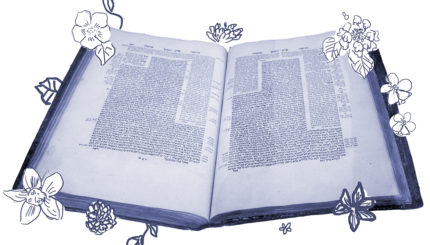Beginners especially may find Talmud study a difficult task. The logic can be convoluted, while every page alludes to customs, political arrangements, and so on which were once everyday reality but are now terribly obscure. Worst of all, the whole effort must be made with translated texts, unless the student can master Hebrew and Aramaic even before starting. It must therefore be emphasized that the necessary background can be acquired. People have done so in every generation, and people can do so now. The texts are translated; introductions, explanations, and commentaries have been written; Hebrew has been revived as a spoken tongue. The would‑be beginner need only supply the will.
It may also help to bear in mind that Talmud study can be tremendous fun. Like any challenging task, the task of understanding an unfamiliar talmudic passage is intimidating only until it has once been accomplished. After that, the challenge can be relished, and the task enjoyed.
The fact is, after all, that the Talmud is interesting, The people represented in it were intelligent, articulate, and dedicated to the remarkable project of helping an ancient tradition survive mortal danger. The arguments stimulate, their language gives pleasure, the immensity of their achievement provokes awe.
With your help, My Jewish Learning can provide endless opportunities for learning, connection and discovery.
There is wit in the Talmud, and humor too. There are wonderful stories, and logic whose disciplined sharpness is breathtaking. The Talmud has been compared to the sea; you never enjoy swimming anywhere until you’ve gotten used to the water. Getting wet can be uncomfortable at first, but after that “the water’s fine”: the pleasure keeps mounting.
But what does it mean to study the Talmud; how is it to be done? In our time, the Talmud exists primarily in print, as a book, and our culture tends to see reading as a private activity. Even the reader of this book probably is sitting alone somewhere, trying to concentrate on its pages. People not reading alone usually are found in large groups, either listening to a lecturer explain a text, or in a classroom, engaged in group discussion.
Neither of these settings, however, reflects the manner of Talmud study in the traditional yeshiva. There, students study in pairs. reading every word of the text out loud, never going on to the next phrase until they have exhausted the meaning of the one under discussion. The Talmud itself, after all, originated as oral discussion, and still has the form of an elaborate conversation carried on over centuries. Its standard way of citing an opinion is “Rabbi X says . . . “; later generations of rabbinic disciples listened to Rabbi X, and answered back.
This mode of study, called in Aramaic havruta (“fellowship”), turns text study into dialogue and makes books into tools for overcoming, not strengthening, isolation. It makes the tradition of rabbinic learning a powerful source of community cohesion, a source of speech rather than silence. This activity was usually called not “study” but “learning,” and in every Jewish community an invitation to fellowship could take the form of the proposal “Let’s learn together.” The life of the mind and the life of society were thus made one.
In the past, it was also taken for granted that one needed a teacher to study Talmud properly. Those pairs of students in the yeshiva always know whose disciples they are, and regularly gather to hear “the rabbi” lecture, or to be examined by him one by one. In an extreme statement, ancient rabbis are quoted as having said that even one who has memorized the whole Bible, and the Mishnah too, is still only an ignoramus, heretic, or even worse, unless he has also “served the Sages,” that is, has carried out a proper apprenticeship with a master (Sotah 22a).
The advice still has force, especially for the beginner. The world of Talmud is an exceedingly complex one; a first entry into it through books is like looking up a word in a foreign‑language dictionary. Every choice the dictionary offers is in some sense a translation of the word in question, but only one really captures the correct meaning in context; others may amount to grotesque errors.
So too the Talmud’s habit of assuming whenever it talks of one thing that the student already understands ten others makes it useful to have access to a teacher who can put everything into a helpful framework, who can say when some term or idea is mentioned in place X that it’s really explained in place Y. Such living sources of guidance have saved countless novice talmudists from despair.
They are not, however, indispensable…[M]odern students of the Talmud differ from their predecessors in their way of study just as they differ in their purpose in their prior training. Those who can find a teacher or a class which match them in aim and in atmosphere are fortunate to be sure, but… [there are bibliographies] designed for the modern reader who wishes to sample the Talmud in the way most modern books are read‑‑alone, with ready access to printed study aids, but without the constant presence of a colleague or a guide. Pirke Avot 1.6 advises “Acquire a companion,” but not everyone is so lucky.
Reprinted with permission from Back to the Sources: Reading the Classic Jewish Texts, published by Simon & Schuster.
Avot
Pronounced: ah-VOTE, Origin: Hebrew, fathers or parents, usually refering to the biblical Patriarchs.
Mishnah
Pronounced: MISH-nuh, Origin: Hebrew, code of Jewish law compiled in the first centuries of the Common Era. Together with the Gemara, it makes up the Talmud.
Talmud
Pronounced: TALL-mud, Origin: Hebrew, the set of teachings and commentaries on the Torah that form the basis for Jewish law. Comprised of the Mishnah and the Gemara, it contains the opinions of thousands of rabbis from different periods in Jewish history.
yeshiva
Pronounced: yuh-SHEE-vuh or yeh-shee-VAH, Origin: Hebrew, a traditional religious school, where students mainly study Jewish texts.


